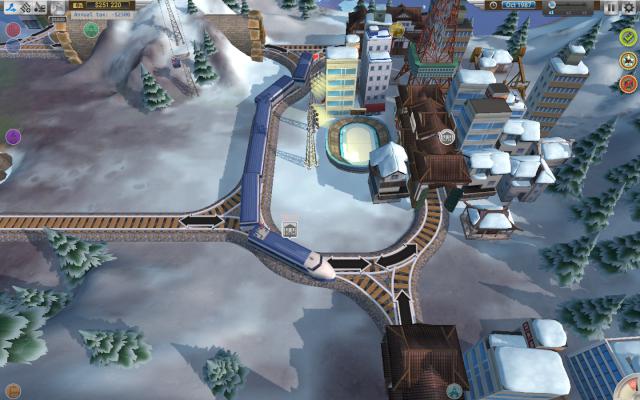
Train Valley is a puzzle game. With trains. If you don’t like puzzle games and don’t like trains, you’ll want to be heading to another review for a bit. You will, however, be missing out on a pretty fun game.
The idea of Train Valley is simple enough on the surface – you’ve got some stations which need joining up with track in such a way that lets you send trains between them. Laying track costs money, but you can earn it back by getting trains to their colour-matched destinations on time. Simple enough so far. You can route trains through various junctions and suchlike to alter their route if needs be, and with several trains on the rails at any one time you’ll want to avoid making them crash into each other or off the end of an unfinished bit of railway.
Written like that, there’s not much by way of challenge. But that comes with the realisation that the trains each have a value when they’re ready to leave the station, and the longer it takes to get a train from A to B the less cash you’ll earn as a result. And it doesn’t take long before you realise how much of a challenge this becomes. You’ll want to build more complex rail layouts, but can’t because of a lack of funding. So you try to push through a few trains early and get a few more notes under your belt, but you can’t keep up and they end up crashing into each other. Careful planning is a must (and you can pause the game to think about what to do next) and as the difficulty increases there’s just as much importance on track design and layout as there is deciding which trains to send on which bit of track at which moment. There’s a lot to think about, and a far bigger challenge than the earlier levels would have you believe.

Considering the game is visually relatively simple, there’s a good amount of variety in terms of locations and time periods you can work in. Whether you’re in Europe, Japan, America or the old USSR the game look every bit as nice as it needs to, and with a time period spanning 200 years from the early 1800s into the near future there are loads of different trains to use too. It doesn’t make a great deal of difference to the playability apart from thing being a bit quicker and the trains being longer (which does make things slightly more tough), but it’s nice to have some new stuff to look at as things get more tricky.
Beating levels also unlocks the sandbox mode, which lets you play around with various levels without money constraints holding you back. It’s basically an excuse to play with a virtual train set, and while most people won’t put Call of Duty down to play trains, it gave a nice pang of nostalgia to my childhood which others might also enjoy. It’s largely pointless, but you could say that about a lot of games.
There are some frustrations though, coming in the shape of some levels seeming a little unfair and random (mainly thanks to the fact they are slightly random) and the inability to undo track placement means you can easily end up with a clogged up mess instead of a nice neat area of intersections, ruining the level before it’s really gone anywhere. It’s also quite short, and while the later levels are difficult enough to make things last a bit longer you won’t still be playing in 3 month’s time unless you’re really absorbed into the sandbox mode.
But let’s not forget that this is available for under £7, and for a couple of week’s gaming you might say that the content available isn’t too bad if you enjoy a good puzzle game with a twist. Puzzle game fans will love it, and those who like their trains will probably get a good kick out of the sandbox mode and various locations and time periods. It’s not bad at all, and definitely worth giving the demo a go at the very least.
Reviewed on PC


Leave a Reply